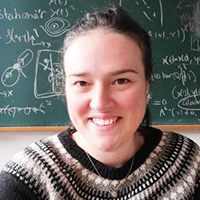By Burcu Gürbüz
Figure 1. The
Aedes aegypti mosquito transmits dengue fever, a viral disease that is a major public health concern. Figure courtesy of
iStock.com/nopparit.
The
10th International Congress on Industrial and Applied Mathematics (ICIAM 2023) took place in Tokyo, Japan, from August 20-25. ICIAM 2023 brought together researchers, scholars, and other experts from around the world to discuss and exchange ideas, present their latest work, and network and foster collaborations. A variety of invited talks, special lectures, and minisymposia addressed numerous topics in applied mathematics, including data science and machine learning, industry collaborations, financial math and risk management, climate modeling and environmental sustainability, and healthcare modeling and epidemiology.
A contributed session on “Stability Theory for Ordinary Differential Equations” was particularly relevant to many aspects of dynamical systems modeling and analysis. Our talk within this session analyzed the progression of dengue fever to illustrate disease model mechanisms more broadly. Dengue fever is a viral disease that is transmitted by Aedes mosquitoes (see Figure 1); it remains a major public health concern, particularly in tropical regions. Because symptoms can range from a mild fever to severe complications, researchers are eager to understand dengue’s complex transmission dynamics [5]. Recent studies have illustrated mathematical modeling’s ability to help comprehend and manage this mosquito-borne threat [1].
The use of time delays in disease spread models represents the complex dynamics of infectious diseases. Time delays account for the temporal intricacies of transmission by encompassing the gaps between exposure, infection, and the onset of contagiousness. In disease spread models, these delays reflect the realistic progression of an outbreak and provide a more accurate representation of an infection’s spread over time, which affects the speed and extent of an epidemic [3]. To incorporate this idea, we developed a sophisticated SEIR-SEI model that encompasses susceptible (S), exposed (E), infectious (I), and recovered (R) compartments for human populations and susceptible (S), exposed (E), and infectious (I) compartments for vector populations — along with the critical element of time delays [4]. Our study employed next-generation matrix techniques to calculate the basic reproduction number \((R_0)\): a crucial parameter for the evaluation of infectious disease transmission [2]. We also proved the local and global stability results in relation to \(R_0\).
Figure 2. Evolution of the model over time. 2a. No time delays. 2b. Inclusion of time delays in the relevant terms. Figure courtesy of the author.
In order to develop a qualitative analysis approach for the model, we performed a nondimensionalization — a mathematical technique that removes the partial physical dimensions from the system and allows us to interpret the simulation results. Doing so revealed equilibrium points within the model that represent the disease-free and endemic states, thus providing critical insights into dengue's behavior. Stability analysis is an indispensable tool that allows researchers to understand the evolution of infectious diseases over time. We hence employed time delays to explore our model’s stability and investigate whether dengue would persist or die out under different parameter settings; Figure 2 depicts the evolution of the model over time with and without time delays. Finally, we utilized numerical investigation to understand the model’s time evolution with appropriate parameters. As expected, the time delay caused a significant difference in the bifurcation and stability analyses.
In the future, we intend to further evaluate the model and study optimal control strategies based on our current findings.
Burcu Gürbüz delivered a contributed presentation on this research at the 10th International Congress on Industrial and Applied Mathematics, which took place in Tokyo, Japan, in August 2023.
Acknowledgments: I would like to acknowledge my coauthors—Aytül Gökçe (Ordu University), Segun Oke (Ohio University), Michael Adeniyi (Lagos State University of Science and Technology), and Mayowa Ojo (Thermo Fisher Scientific)—for their valuable contributions to our research study. Additionally, I extend my thanks to the Financial Support Program Committee of ICIAM 2023 and Johannes Gutenberg University Mainz for their generous support of my attendance at the conference.
References
[1] Aguiar, M., Anam, V., Blyuss, K.B., Estadilla, C.D.S., Guerrero, B.V., Knopoff, D., ... Stollenwerk, N. (2022). Mathematical models for dengue fever epidemiology: A 10-year systematic review. Phys. Life Rev., 40, 65-92.
[2] Gökçe, A., Gürbüz, B., & Rendall, A.D. (2023). Dynamics of a mathematical model of virus spreading incorporating the effect of a vaccine. Preprint, arXiv:2307.12707.
[3] Gülsu, M., Gürbüz, B., Öztürk, Y., & Sezer, M. (2011). Laguerre polynomial approach for solving linear delay difference equations. Appl. Math. Comput., 217(15), 6765-6776.
[4] Ojo, M.M., & Akinpelu, F.O. (2017). Lyapunov functions and global properties of SEIR epidemic model. Int. J. Chem. Math. Phys., 1(1), 11-16.
[5] World Health Organization. (2011). Comprehensive guideline for prevention and control of dengue and dengue haemorrhagic fever. WHO Regional Office for South-East Asia. Retrieved from https://iris.who.int/handle/10665/204894.
 |
Burcu Gürbüz is a postdoctoral researcher in the Institute of Mathematics at Johannes Gutenberg University Mainz in Germany. Her main research interests include dynamical systems, differential equations, qualitative analysis, mathematical biology, numerical methods, and programming. Among other works, Gürbüz uses mathematical methods to construct and analyze models that improve our understanding of the climate system. |